

 |
Search the Site with

|
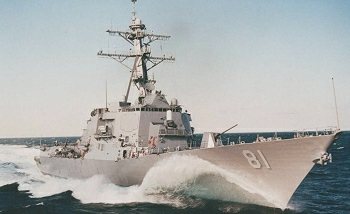 | 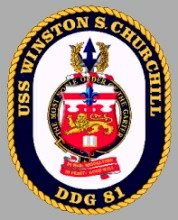 | 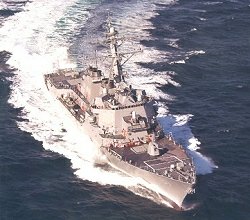 |
USS WINSTON S. CHURCHILL is the 31st ARLEIGH BURKE class guided missile destroyer and fourth US warship named after an Englishman. As a courtesy to the ship's namesake country, a member of the Royal Navy is assigned to the ship's crew at all times.
| General Characteristics: | Awarded: June 6, 1995 |
| Keel laid: May 7, 1998 | |
| Launched: April 17, 1999 | |
| Commissioned: March 10, 2001 | |
| Builder: Bath Iron Works, Bath, Maine | |
| Propulsion system: four General Electric LM 2500 gas turbine engines | |
| Propellers: two | |
| Length: 508,5 feet (155 meters) | |
| Beam: 67 feet (20.4 meters) | |
| Draft: 30,5 feet (9.3 meters) | |
| Displacement: approx. 9,200 tons full load | |
| Speed: 32 knots | |
| Aircraft: two | |
| Armament: one | |
| Homeport: Mayport, Fla. | |
| Crew: approx. 320 |
Crew List:
This section contains the names of sailors who served aboard USS WINSTON S. CHURCHILL. It is no official listing but contains the names of sailors who submitted their information.
USS WINSTON S. CHURCHILL Cruise Books:
USS WINSTON S. CHURCHILL's Commanding Officers:
| Period | Name |
|---|---|
| March 10, 2001 - April 19, 2002 | Commander Michael T. Franken, USN |
| April 19, 2002 - February 2004 | Commander Holly A. Graf, USN |
| February 2004 - February 2006 | Commander Todd W. Leavitt, USN |
| February 2006 - October 2007 | Commander Nelson C. Castro, USN |
| October 2007 - January 2008 | Commander Mark J. Oberley, USN |
| January 2008 - August 2009 | Commander Fred I. Pyle, USN |
| August 2009 - February 2011 | Commander Juan J. Orozco, USN |
| February 2011 - August 2012 | Commander Michael E. Hutchens, USN |
| August 2012 - February 2014 | Commander Christopher D. Stone, USN |
| February 2014 - September 2015 | Commander Christine R. O'Connell, USN |
| September 2015 - May 2017 | Commander Paul M. Allgeier, USN |
| May 2017 - present | Commander Tom M. Van Scoten, USN |
Accidents aboard USS WINSTON S. CHURCHILL:
| Date | Where | Events | ||
|---|---|---|---|---|
| January 9, 2003 | The maintenance crew was working on a helicopter on the flight deck, when the WINSTON S. CHURCHILL is hit by a large wave causing extensive to the helicopter and nearly washing one crewmember overboard. | |||
| August 22, 2005 | off Jacksonville, Fla. | USS McFAUL (DDG 74) collides with the USS WINSTON S. CHURCHILL during exercises off the coast of Jacksonville, Fla. Both ships receive only minor damage and no injuries are reported. The bow damage on McFAUL can be seen on the photos below.
|
About the Ship’s Coat of Arms:
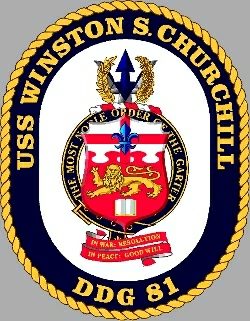 The Shield:
The Shield:
The cross of St. George and the fleur-de-lis are adapted from Churchill's augmentation on an inescutcheon on his ancestral coat of arms. Red is emblematic of valor and sacrifice. The red cross on the white field refers to the flag of St. George, who became the patron of the Order of the Garter in 1348. The gold lion on the red field recalls Great Britain's heritage. The lion embodies strength, courage and determination. The nebuly alludes to the sky or clouds and highlights Britain's taking of the full thrust of German airpower in the Battle of Britain. The stylized book underscores Winston Churchill's reputation, not only as a gifted statesman and inspiring war leader, but also a great orator and author who was awarded the Nobel Prize in literature. He unified the British people with his stirring oratory, energy and resolve.
The Crest:
The trident symbolizes sea prowess and highlights USS Winston S. Churchill's vertical launch capabilities; the three tines represent anti-submarine, surface, and air warfare capabilities. The trident is divided per chevron suggesting a "V" emphasizing victory in war (Winston Churchill's famous rallying sign) and defense strength in peace. The laurel recalls honor and high achievement; while the oak represents strength and resolve.
About the Ship’s Name, about Sir Winston Leonard Spencer Churchill:
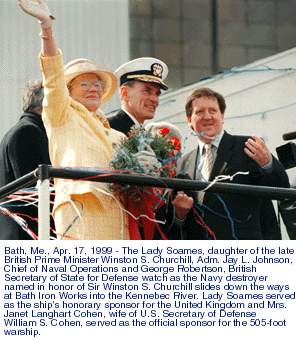 The only statesman to achieve high office in both World Wars and to write profusely about his experiences, Winston Churchill dominated the 20th Century like few other individuals. Although best known for his courageous leadership as British prime minister during World War II, Churchill was a formidable political thinker and one of the highest-paid journalists from the days of Queen Victoria's "little wars" to his memoirs of World War II.
The only statesman to achieve high office in both World Wars and to write profusely about his experiences, Winston Churchill dominated the 20th Century like few other individuals. Although best known for his courageous leadership as British prime minister during World War II, Churchill was a formidable political thinker and one of the highest-paid journalists from the days of Queen Victoria's "little wars" to his memoirs of World War II.
A larger-than-life character, famous for his trademark cigar and his overblown reputation as a drinker (which he joyfully exaggerated), Churchill was also a talented amateur painter and pilot, soldier, farmer, bricklayer, and orator. When he retired from the House of Commons in 1964, he had spent over six decades in public life, a career that ran from the last great British cavalry charge to the nuclear age.
Born in 1874 to Lord Randolph Churchill and an American mother, the former Jennie Jerome, Winston spent a typical upperclass childhood in the hands of nurses and headmasters at a succession of private schools. While he was no more neglected than most boys of his age and class, his sensitive nature recoiled at his parents' aloofness and he always regretted his failure to achieve a close relationship with his father, who died in 1895 at the age of only 45. His mother later became his ardent ally, helping him achieve key assignments as a war reporter and smoothing his career in politics.
In late 1900, Churchill was elected to Parliament as a Conservative and took his seat in early 1901. His independent nature soon saw him at odds with his party, and in 1904 he "crossed the floor" to the Liberals, who won a landslide election in early 1906. He served the Liberal government as President of the Board of Trade and Home Secretary, where he helped introduce social legislation that laid the foundations for the later welfare state. In 1911, he became First Lord of the Admiralty (civilian head of the Royal Navy), working feverishly to complete the conversion of ships from coal to oil power. Together with his two First Sea Lords, Prince Louis of Battenberg and Admiral Lord Fisher, Churchill promoted fast, powerful battleships and outbuilt the Germans to maintain British naval supremacy. He founded the Naval Air Service, and made numerous visits to ships and navy bases, where he was admired for his efforts to improve conditions for officers and crews.
At Churchill's direction, the fleet was at its war station before war broke out in 1914, but it was never able to engage the Germans in a decisive early sea battle. Worse, Churchill's support of a failed campaign to force entry in the Dardanelles "by ships alone" caused his removal from the Admiralty in May 1915. Reporting to his regiment in the trenches of Belgium, he was under fire for three months before returning to Parliament. In 1917 he was appointed Minister of Munitions and, in 1919, Secretary for War and Air.
As Colonial Secretary in 1921-22, Churchill enjoyed two notable diplomatic achievements. At the 1921 Cairo conference, he helped establish the borders of the modern Middle East, though he failed in his attempt to set up a Kurdish homeland "to protect the Kurds against some future bully in Iraq." Closer to home, he helped to forge the Irish Treaty, which kept the peace in Ireland for 50 years. Michael Collins, the IRA revolutionary with whom Churchill negotiated, said from his deathbed: "Tell Winston we could have done nothing without him."
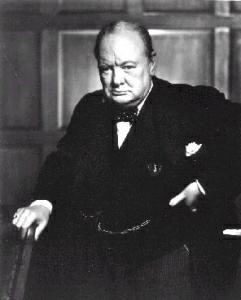 In 1924, Churchill rejoined the Conservatives, serving as Chancellor of the Exchequer through spring 1929. He returned Britain to the gold standard and ran a government newspaper, "The British Gazette," during the general strike of 1926. He became increasingly separated from the Conservatives in the 1930s, first over the plan to grant India dominion status; later over Britain's slow rearmament in the face of Hitler's aggression; and finally when he championed King Edward VIII, who abdicated in 1936. Not until war had broken out again in 1939 was he asked to rejoin the Government - again becoming First Lord of the Admiralty, which according to legend, signaled to its ships: "Winston is Back." He renewed his energetic naval policies but was repulsed in an attempt to wrest Norway from the invading Germans in April 1940.
In 1924, Churchill rejoined the Conservatives, serving as Chancellor of the Exchequer through spring 1929. He returned Britain to the gold standard and ran a government newspaper, "The British Gazette," during the general strike of 1926. He became increasingly separated from the Conservatives in the 1930s, first over the plan to grant India dominion status; later over Britain's slow rearmament in the face of Hitler's aggression; and finally when he championed King Edward VIII, who abdicated in 1936. Not until war had broken out again in 1939 was he asked to rejoin the Government - again becoming First Lord of the Admiralty, which according to legend, signaled to its ships: "Winston is Back." He renewed his energetic naval policies but was repulsed in an attempt to wrest Norway from the invading Germans in April 1940.
With the Nazi blitzkrieg pouring into the Low Countries, Churchill succeeded Neville Chamberlain as prime minister on May 10, 1940 and presided over a year of devastating defeats. In those months, when Britain stood alone and almost unarmed against Hitler, as Edward R. Murrow said, "he mobilized the English language and sent it into battle." After Hitler attacked Russia in June 1941, Churchill vowed to help the Soviets, declaring, "if Hitler invaded hell I would at least make a favorable reference to the Devil in the House of Commons." Establishing close ties with President Roosevelt, he secured American military aid and moral support, but his ultimate goal was to have America fighting at Britain's side. When the United States was drawn into the war by Japan's attack on Pearl Harbor, Churchill admitted that he "slept the sleep of the saved and the thankful."
Churchill was disappointed by the failure to control an expansionist Soviet Union toward the end of the war, and watched with mounting concern another totalitarian state rise dominant in Europe. To the amazement of many outside Britain, his party was routed in the 1945 general election and he became Leader of the Opposition. His famous "Iron Curtain" speech at Fulton, Missouri in 1946 was the opening salvo and warning of the Cold War, unpopular at the time but later considered prophetic. In 1949, he predicted the demise of Communism, "ignited by a spark coming from God knows where, and in a moment the whole system of lies and oppression is on trial for its life."
In 1951 the Conservatives regained an electoral majority and Churchill became prime minister again, but he was disappointed in his effort to achieve a peaceful settlement of cold war antagonisms, and his domestic record was indifferent. He became a Knight of the Garter, acquiring the title "Sir Winston," in 1953.
Churchill won the 1953 Nobel Prize for Literature, bestowed for his numerous books on history, biography and politics. His greatest biography was "Marlborough" (4 volumes, 1933-38); his best-known historical work was "A History of the English-Speaking Peoples" (4 volumes, 1956-1958). His personal memoirs, "My Early Life" (1930), "The World Crisis" (5 volumes, 1923-31) and "The Second World War" (6 volumes, 1948-53) are readable personal accounts of his Victorian youth and the two world wars. In all, Churchill wrote over 40 titles in over 60 volumes, nearly 1,000 articles and uncounted speeches. His official life, by his son Randolph and Sir Martin Gilbert, is the longest biography ever published.
Asked to summarize Churchill in one sentence, Gilbert said: "He was a great humanitarian who was himself distressed that the accidents of history gave him his greatest power at a time when everything had to be focused on defending the country from destruction, rather than achieving his goals of a fairer society."
To Martin Gilbert also we owe these last lines from Sir Winston's biography: "When at last his life's great impulses were fading, Churchill's daughter Mary paid him perhaps the most eloquent tribute of all: 'In addition to all the feelings a daughter has for a loving, generous father, I owe you what every Englishman, woman & child does -- Liberty itself.'"
Suffering from age and poor health, he retired in April 1955, but remained a Member of Parliament for another nine years. In 1963 he was declared an Honorary Citizen of the United States by President John F. Kennedy. He died at age 90 on January 24, 1965.
USS WINSTON S. CHURCHILL Patch Gallery:
 | 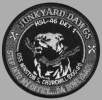 |
USS WINSTON S. CHURCHILL Image Gallery:
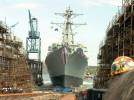 | 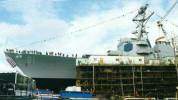 |  | 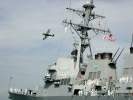 | 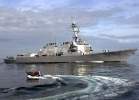 |
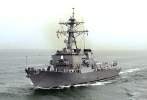 |  |  Photo by IS1 Holly Hogan | Click here to view more photos. | |
The photos below were taken by me and show the WINSTON S. CHURCHILL at BAE Systems Norfolk Ship Repair, Norfolk, Va., on November 10, 2008.
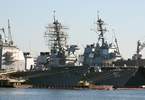 | 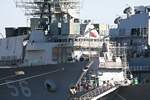 |
The photo below was taken by Michael Jenning and shows the WINSTON S. CHURCHILL at BAE Systems Norfolk Ship Repair, Norfolk, Va., on October 28, 2013.
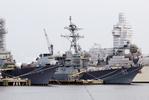 |
The photos below were taken by Michael Jenning and show the WINSTON S. CHURCHILL at Naval Base Norfolk, Va., on May 8, 2014.
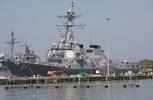 |  | 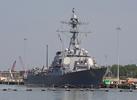 |
The photos below were taken by Michael Jenning and show the WINSTON S. CHURCHILL at Naval Base Norfolk, Va., on October 23, 2014.
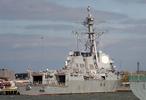 | 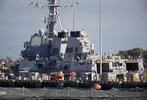 |  |
The photos below were taken by Michael Jenning and show the WINSTON S. CHURCHILL undergoing a Selected Restricted Availability (SRA) at the Marine Hydraulics International Inc. Shipyard at Norfolk, Va., on April 13, 2016. Note the rarely seen gold Battle E on the ship's bridgewing indicating that the WINSTON S. CHURCHILL was awarded the Battle E in five consecutive years.
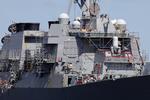 | 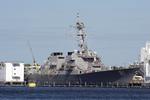 |
The photos below were taken by Michael Jenning and show the WINSTON S. CHURCHILL at Naval Base Norfolk, Va., on October 12, 2016.
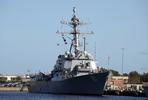 | 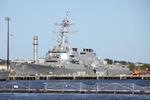 |
The photos below were taken by me and show the WINSTON S. CHURCHILL with USS MITSCHER (DDG 57) alongside at HMNB Clyde in Faslane, Scotland, on September 30, 2017 (the first two photos) and shortly after departure from the Naval Base one day later to join Exercise Joint Warrior 172.
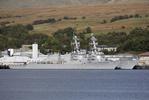 | 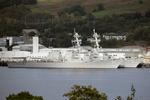 | 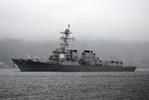 | 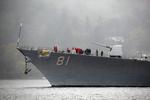 | 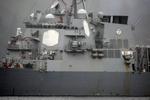 |
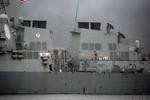 | 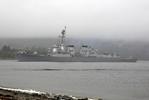 | 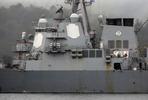 | 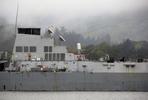 | 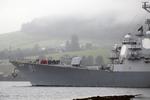 |
 | 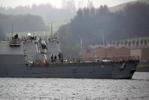 | 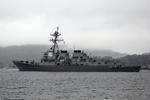 | 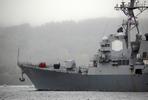 |
 Back to Destroyers list.
Back to Destroyers list.  Back to ships list.
Back to ships list.  Back to selection page.
Back to selection page.  Back to 1st page.
Back to 1st page.